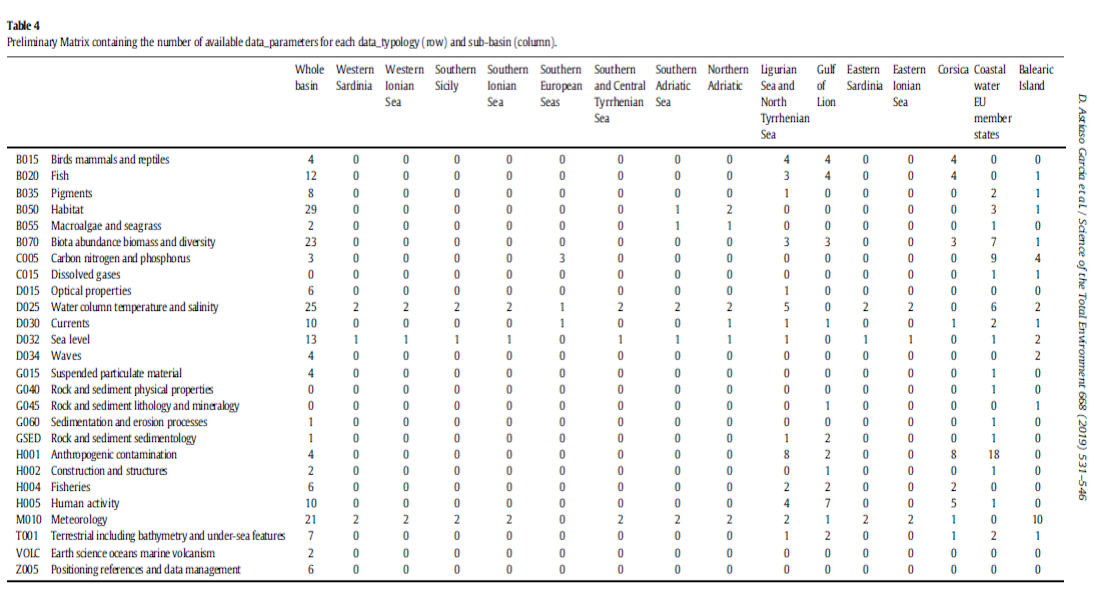Research headed by ODYSSEA project Italian partner Davide Astasio Garcia of the Sapienza University of Rome was published by the academic journal Science of the Total Environment for its June 10, 2019 edition.
In the context of the EU-funded ODYSSEA project the article highlighted the importance of ODYSSEA’s goals. The paper joins the growing body of academic articles published through ODYSSEA. The publication concludes that large parts of the Mediterranean are lacking data parameters for many of the data typologies surveyed.
“On the international scene, it appears of great importance that the marine sector is equipped with an integrated environmental platform, operational and usable, that obeys the international standards required by the various projects,” the researchers wrote in the article, titled An identification and a prioritisation of geographic and temporal data gaps of Mediterranean marine databases.
“In this context, this research has been carried out within the H2020 research project ODYSSEA (Operating a network of integrated observatory systems in the Mediterranean Sea) whose main goal is to develop, operate and demonstrate an interoperable and cost-effective platform that fully integrates networks of observing and forecasting systems across the Mediterranean basin, addressing both the open sea and the coastal zone.
In order to protect, conserve and manage the marine environment, ODYSSEA generally aims to collect, integrate and make interoperable the numerous existing systems and platforms managing marine environmental data for the Mediterranean Sea,” the team explained.
Following on ODYSSEA’s goal, the team described their research as constituting “the first essential pillar for achieving the overall project objectives”, with its objectives of:
- Analysing the reliability and usefulness of the existing monitoring systems at the Mediterranean basin level, organizing them into a structured inventory and identifying the critical issues and shortcomings considering and integrating biological, geological, chemical and physical properties of the Mediterranean Sea.
- Elaborating and applying a new method for identifying geographical and temporal marine data gaps and for providing a prioritisation of missing data.
“Therefore, this paper illustrates the methodological approach used both for the preparation of the data inventory, reviewing all the existing databases, and for the elaboration of a new procedure [to] prioritise data gaps, based on precise and adequate statistical method,” they added.
Other ODYSSEA partners participated in the research by identifying existing data sources from their own country and analysing Earth Observation facilities and networks (platforms with online models, satellite data, in-situ systems, citizen scientist networks) containing Mediterranean status databases maintained by agencies, public authorities, research institutions and universities, the team noted in the article.
The resulting prioritisation of existing geographical and temporal data gaps across the Mediterranean basin was the final product that the researchers presented in the publication.
The obtained results indicate that 76 percent of the data comes from ongoing platforms, while the remaining 24% are related to platforms with non-operational monitoring systems.
As a multidisciplinary analysis of data parameters combining the biological, geological, chemical and physical branches of the total environment, the prioritisation could be useful for end-users’ specific needs in the contexts of environmental quality, ecological health and human health monitoring activities, the researchers said, adding that the implementation of all the existing information in a single dataset may be considered as a starting point for further processing and analysis.
The team headed by Astiaso Garcia included Marina Amori and Franco Giovanardi of the Italian National Institute for Environmental Protection and Research (ISPRA), Giuseppe Piras, Daniele Groppi and Fabrizio Cumo of the Sapienza University of Rome’s Interdepartmental Centre for Landscape, Building, Conservation and Environment, and Livio de Santoli, also of the Department of Astronautics, Electrical and Energy Engineering at the Sapienza University of Rome.


